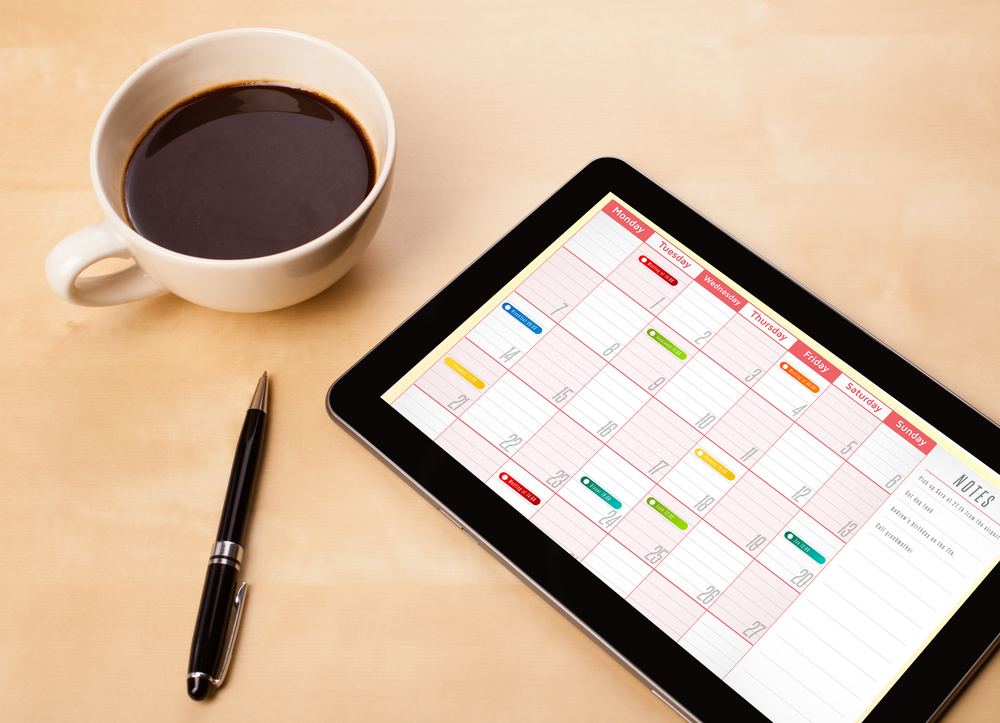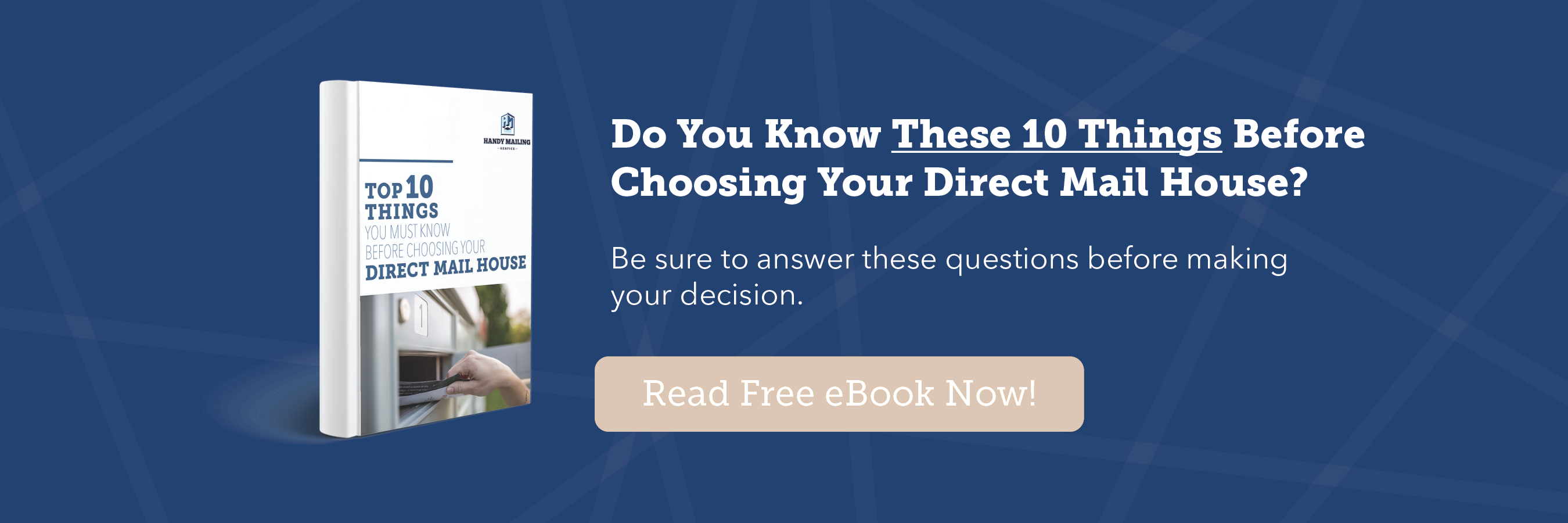The start of a new year offers the chance to step back, relax, take a deep breath, and review all the progress we made the year before. When we do this, we notice we’ve had some good times (and not so good, too). We’ve seen success. And failure. But whether our past year was better than the year before, stepping back and reviewing is always a positive thing.
So, let’s do that here. How was your direct mail last year? Good? Bad? Ugly?
Ask and answer these 10 questions before choosing your direct mail house.
Even if you had a good year, I think it could be better, so let me suggest three things you can do to really rock your direct mail in the upcoming year.
- Clean up your list
- Mix it up
- Schedule it out

Clean It Up
A great place to start in the upcoming year is with your list. The list makes up about 40% of each direct mail campaign, so having a pristine list can fuel your direct mail success more than any other aspect of your marketing efforts.
But the challenge: where do you begin? What are the concrete, visible next actions to take on your list?
Let’s start with ensuring the addresses are up to date. Sounds easy, right? Not really. In fact, this might be the hardest step, because in some cases you’ll need to contact your customers directly. For businesses, you can simply use Google and pull the current information from Google. Since most people use Google to search for information, more and more businesses are keeping their contact information current. But for consumers, that doesn’t work. Instead, you’ll need to run your list through National Change of Address, a service used by mail houses to update the location of all people throughout the world. In fact, we provide this service for our customers all the time and would be happy to provide it to you too.
Besides making addresses current, it’s important to make sure the addresses are specific. What do I mean? I mean that if you have an address that’s 123 Barrel Roll Circle – and you wish to abbreviate the word “circle” – use “cir” not “cr.” “Cr” actually stands for “county road,” and if that’s in your address your mail might not deliver. Let’s look at some other example: Pkwy is parkway. Fwy is freeway. And “sr”? A lot of people think this is state road. It’s actually nothing.
Cleaning up your list might require a lot of time, and you might think it’s not worth it, but nothing can be further from the truth. Taking good care of your list is the surest route to better results in direct mail.
Mix It Up
The second thing you can do besides cleaning your list is to try something new. If you typically send 8.5 x 11 letters inserted into a #10 envelope – try sending a postcard. As a matter of fact. Go bigger – literally. Send an 11 x 14 postcard. Those customers used to seeing those same #10 envelopes from the same company express only mirth when they see a jumbo card from you.
Or maybe you only send postcards because you know it works. It’s what drives your business. Fair enough. If that’s the case, then focus on your current postcard design. Try jazzing it up. Add colors, graphics, bold headers – anything to grab attention and lock your customers’ eyes right onto the piece.
The Ultimate 6-Point Checklist For Mailing A Postcard
What about letters? There is a lot you can do with letters. For starters, no one has placed size restrictions on you. If you typically print 8.5 x 11, try printing on 11 x 17 or 8.5 x 14. Try smaller. We’ve seen a lot of customers have success with “lift notes,” very small letters that look like handwritten notes, like a memo you’d pass to your co-worker. As long as you can fit them into envelope, you’ll be just fine.
But besides the letter, your envelope is really a blank slate awaiting your creativity. We’ve seen, literally, thousands of different envelopes through the years. And you would not believe what people print on them. You can print anything you want – colors, graphics, pictures, abundant copy – anything. We do this all the time for our customers and would love to provide this service to you.
Next, postage. It’s easy to fall into the trap of sending the cheapest postage possible. Most of our mail pieces leave the shop as Presort Standard, but we’ve seen an increasing number of customers switch exclusively to First Class. First Class is more expensive, sure, but if the return on these mail pieces exceeds the cost of postage – that might not matter. Businesses choose First Class postage for two reasons:
- It’s fast
- You don’t need a barcode
Not much needs to be said about speed. Speed is speed. And most often, faster is better. But let’s look at the second point. On most mail, the Post Office requires a barcode on the mail piece. This allows their machines to read mail at a faster rate and process the mail smarter. That’s great for the Post Office. Unfortunately, the barcode doesn’t feel very personal. And yet, to market to your customers you need to be personal. A lot of customers will have 10 or more variable fields in their letters, but then they mail Presort Standard and muddy all that personalization with a barcode.If you mail First Class, you don’t this barcode, and you will automatically grow in personalization.
Drive Them Online
We’re beginning to see more and more mail pieces that operate as vehicles to drive consumers online. This often occurs in the form of a postcard, which offers details about a free download from a website landing page. Other times, a sales letter will seek to convince a person of the sell, but to order the product, the reader must go the company’s website. This is a great idea. Driving customers onto your website gives you rise to a whole new level of metrics. With the right software, you can track when they go to your website, how long they’re spending on each web page, etc… Over time, with this data, you can adjust your strategy. For what it’s worth, we use Hubspot as our CRM, and we’ve been blown away by what it can track. The data it’s given us has been invaluable for sending our own direct mail pieces.
These are just some of the things you can do to mix it up. If you want even more ideas, check out this blog for a plethora of new ideas and strategies to propel your direct mail campaign even more.
21 Ideas For Your Next Direct Mail Campaign
Schedule It Out
As important as all of this is, nothing matters if you don’t schedule. Direct mail require intention, time, and persistence. Mailing something without a plan might be a catastrophic loss to your marketing budget and a blow to your business. So be intentional about what you want to mail this year. Here are a few ideas.
Direct mail require intention, time, and persistence. Mailing something without a plan might be a catastrophic loss to your marketing budget and a blow to your business.
First, sit down with your marketing decision makers. Brainstorm what you want to send in the upcoming year. Don’t be afraid to plan the whole year out, even if you aren’t sure on the specifics. Try to get a rough outline of everything you want to do.

Second, give responsibility to everyone in the group. There’s an adage that goes like: “If two or more people are responsible for something, no one is.” Put one person in charge of each aspect of the planning/production process. This is also where it might be good to add deadlines for each part. Without deadlines, movement will be sluggish and fewer projects will get out the door. But what if you’re a lone ranger? In this case, you must be even more self-disciplined and committed to the schedule. If you’re a person in your company who wears hats other than marketing, the challenge grows even bigger. But don’t panic – do what you can do with the time that you have, and you will see results.
Third, track it all. A perennial challenge of direct mail is that it’s hard to track (one of the benefits of driving people online, by the way). You cast your direct mail pieces into the mouth of the behemoth, the Post Office, and you never see your mail pieces again. Don’t let this discourage you though. You can track it with a few simple steps.
We already alluded to the importance of using your company’s website as a tracking mechanism, but if you’re not using this back-end approach, all you need is a spreadsheet. In the spreadsheet, record each project, the specifications of the mail piece, the number of pieces of mailed, postage, etc… The more data you record, the smarter decisions you’ll make in the future.
And then, For EVERY single person who responds to your mail piece, input the name and the date of when they called or emailed or used whatever channel you’ve setup for responding. Be meticulous. This might seem silly at first, but believe me, after several months of sending direct mail, the information becomes super important. It will shape your future marketing by giving you important insights into your customers’ buying trends.
This upcoming year will be another BIG year for direct mail. Put to use the principles in this blog post and make this next year one to remember. If you’re already doing this, or have seen success by employing other tactics, then shoot us an email or give us a call at Handy Mailing Service. We are passionate about direct mail!


